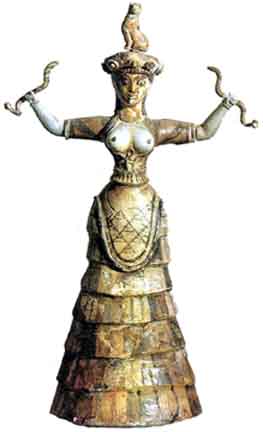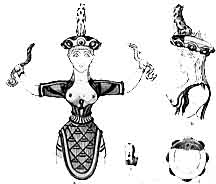Women in the Aegean
Minoan Snake Goddess
Christopher L. C. E. Witcombe
2. The Votary
The faïence figurine known today as the "Snake Goddess" was originally identified by Evans as a "votary". When found it was missing its head, most of its hat, the right arm, the lower part of the snake held in the right hand, and large segments of the skirt.
 
The partial reconstruction in the photographs above was eventually completed with the addition of the left forearm, a hand holding a purely conjectural snake, and the head.
 Fragments believed to be part of the hat enabled its reconstruction, but it was not until a few years later that Evans came to believe that the little faïence figure of a seated cat, which he identified as a lioness or spotted pard, found nearby in the repository, was originally placed on top of the hat (a rivet hole in the base of the cat and another in the top of the hat suggested the connection).
Fragments believed to be part of the hat enabled its reconstruction, but it was not until a few years later that Evans came to believe that the little faïence figure of a seated cat, which he identified as a lioness or spotted pard, found nearby in the repository, was originally placed on top of the hat (a rivet hole in the base of the cat and another in the top of the hat suggested the connection).
The skirt worn by the figure is comprised of seven overlapping flounces; a flounce being a strip of cloth gathered and sewed on by its upper edge only. The lower edge of the first six flounces overhang the upper edge of the one below. The bottom edge of the lowest touches the ground, concealing the figure's feet.
Each flounce appears to be made of a series of square panels, each about 12-15 centimetres square on a full-size example, sown together in a horizontal strip, with a panel of solid colour alternating with a panel decorated with two vertical stripes. These laterally alternating panels are then made to alternate in a vertical pattern - solid panel, patterned panel, solid panel, and so on - from flounce to flounce, producing a checker-board effect.
The flounces would appear to be fairly thick, judging by the roof-tile-like overhang of the profile, and were probably made of wool, which was the main cloth-making fibre of the Minoans. The skirt flares out from the hips to the ground.
Over the hips and falling to the front and to the back is a tongue-shaped double-apron or "polonaise" bordered with stripes and patterned with a simple diagonal grid of lines with a single pair of horizontal lines across the upper portion of each lozenge.
The skirt and apron are secured at the waist by some sort of wide belt or girdle, perhaps fastened at the back (and hidden under her hair), and decorated with vertical lines. The belt or girdle, which Evans thought was perhaps made of metal, emphasizes the figure's slender 'wasp-waist' and accentuates the curve of the hips.
The girdle, as an article of clothing, evidently had a special ritual significance. Among the items found in the Western Repository were two faïence double girdles (and the fragment of a third), one of which is decorated with a saffron-flower pattern.
[The girdles, which can be seen placed on the ground in front of the two figurines in the photograph of Evan's tentative reconstruction of the "Snake Goddess" shrine, are discussed in The Temple Repositories].
The girdle may have some relation to the charmed girdle worn by Aphrodite and which the goddess lent to Hera when she wished to seduce Zeus and thereby distract his attention from the Trojan war (incidentally, the seduction took place on Mount Ida on Crete).
According to Homer (Iliad, Book XIV), Aphrodite "loosed from her bosom the curiously embroidered girdle into which all her charms had been wrought - love, desire, and that sweet flattery which steals the judgement even of the most prudent."
It will be seen that the Minoan "Snake Goddess" may be indirectly linked through the Egyptian goddess Wadjyt with the Greek Aphrodite [see Snakes, Egypt, Magic, and Women].
The bodice, which seems to be made of a plain material, fits tight over the figure's torso and over the upper arms to just above the elbow. It is decorated with dark broad wavy lines tapering down to points at the line of the belt or girdle. A rope-like border runs round the edge of the jacket and also round the edge of the sleeves.
At a point below the breasts, the bodice appears to be clasped or laced across the open gap. A loop which extends vertically above a "knot" at this point between the lower part of the breasts of both figurines may be symbolical.
The bodice is collarless and open in the front down to where it is tucked into the belt or girdle. It has been suggested that the bodice has been deliberately pulled open to reveal the breasts, and what could be interpreted as folds in the cloth, painted in dark glaze, to the sides of each breast lends support to this interpretation.
When seen in profile, the full, rounded breasts, coloured white and with dark-coloured erect nipples, protrude significantly. The wide belt or girdle must also serve to pull in the rib cage, forcing the chest out and adding to the projection of the breasts. Although they might be partially supported by the pulled-back sides of the tight bodice, their firmness and lack of any indication of sagging would suggest that the woman not only is young but also has not yet had any children.
The neck and head of the figurine is a reconstruction, presumably based upon the head of the other "Snake Goddess" and from the numerous examples of women's heads and faces painted in Minoan frescoes. The headpiece is also a reconstruction, based largely on a fragment of the front part which included a series of three dark-painted, raised medallions (see the following illustration).

However, I must admit to having serious reservations about Evans' claim that this fragment is part of a headpiece, and that the headpiece belonged to this figurine. If the reconstruction of the headpiece is incorrect, then so too is the spotted cat sitting on top (although the cat may well have sat originally on this fragment).
As was mentioned above, the left forearm with the snake being held in the left hand is also a reconstruction. The right arm and hand, the flesh of which is white like the breasts, extends out and up away from the body. On the wrist is a thin bracelet.
Only the tail of the snake, which protrudes above her fist, is original; the portion below the wrist, with the head, is a reconstruction. The snake, which would appear to be only about 18 inches long, is shown with a single continuous stripe spiraling its body.
The "Snake Goddess" was one of three figurines discovered amidst a cache of broken and discarded cult objects in what was subsequently called the Temple Repositories at Knossos.
3. THE TEMPLE REPOSITORIES 
|

